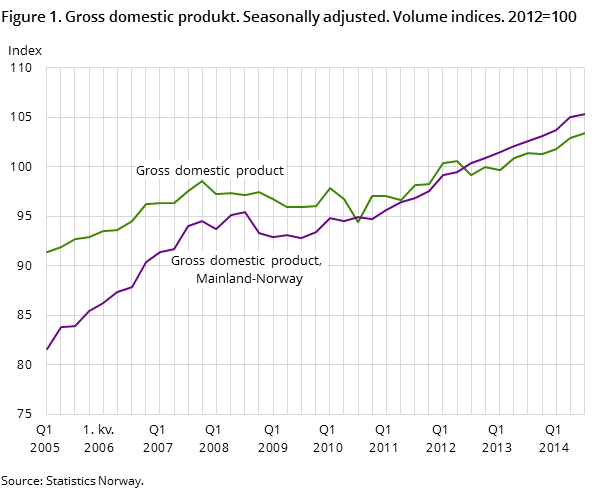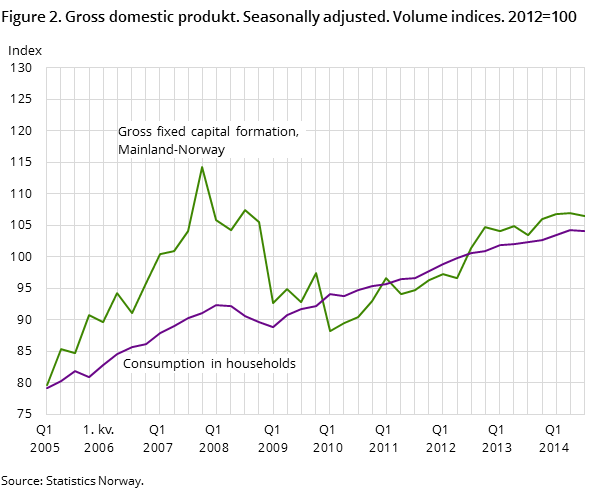Content
Published:
This is an archived release.
Continued moderate growth in mainland GDP
According to preliminary seasonally-adjusted volume figures, Mainland Norway’s gross domestic product (GDP) grew 0.4 per cent from the 2nd quarter to the 3rd quarter this year. After a strong increase in the 2nd quarter, the mainland economy is back at the same level of moderate growth that we have seen in the past one and a half years.
| 20131 | 4th quarter 2013 | 1st quarter 2014 | 2nd quarter 2014 | 3rd quarter 2014 | |
|---|---|---|---|---|---|
| 12013 are preliminary. | |||||
| Gross domestic product | 0.7 | -0.1 | 0.5 | 1.1 | 0.5 |
| Gross domestic product Mainland Norway | 2.3 | 0.5 | 0.6 | 1.2 | 0.4 |
| Petroleum activities and ocean transport | -4.4 | -2.3 | 0.3 | 0.4 | 1.1 |
| Final domestic use of goods and services | 3.6 | 0.8 | -0.2 | 1.7 | 0.3 |
| Final consumption expenditure of households and NPISH | 2.1 | 0.3 | 0.8 | 0.7 | -0.1 |
| Final consumption expenditure of general government | 1.7 | 1.1 | 0.8 | 1.0 | 0.6 |
| Gross fixed capital formation (GFCF) | 6.8 | 1.2 | -0.8 | 0.3 | -0.2 |
| Total exports | -3.0 | -1.2 | 0.8 | -1.4 | 2.1 |
| Total imports | 4.3 | 1.5 | -1.4 | -0.3 | 2.2 |
| Employed persons | 1.2 | 0.2 | 0.3 | 0.3 | 0.2 |
| Total hours worked | 0.7 | 0.4 | 0.4 | 0.4 | 0.3 |


Value added in petroleum activities and ocean transport grew 1.1 per cent in the 3rd quarter, and thus total GDP was up 0.5 per cent.
Negative contribution from electricity production
Production and distribution of electricity was down 9.3 per cent in the 3rd quarter, and had a negative impact on GDP Mainland Norway of 0.2 per cent. There was significant growth in other goods-producing industries, however, such as construction and wholesale and retail trade.
Gross value added in manufacturing increased by 0.7 per cent in the 3rd quarter. Building of ships, oil platforms and modules as well as repair and production of machinery and other equipment made a positive contribution to the growth. The food industry continued to increase in the 3rd quarter, following an increase in the second quarter.
Service activities grew by 0.9 per cent. Service activities incidental to oil have had a decline for four quarters in a row, and continued to decrease in the 3rd quarter. Other than that, most service industries experienced growth.
Value added in general government was up 0.4 per cent, with somewhat stronger growth in central government than local government.
Lower goods consumption
Household final consumption expenditures were down 0.2 per cent, following an increase of 0.7 per cent in the 2nd quarter. Household consumption of goods fell by 0.8 per cent, after an equivalent growth in the previous quarter. Durable goods, such as furniture, white goods and cars made a negative contribution. Electricity consumption also had a marked fall in the 3rd quarter.
Consumption of services grew by 0.7 per cent for the second quarter in a row. Direct purchases abroad by resident households fell by 0.6 per cent, after a period of strong growth.
A slight decrease in investments
Gross fixed capital formation (GFCF) in mainland Norway fell by 0.6 per cent in the 3rd quarter. Lower defence and hospital investments led to a decline in GFCF of central government of 8.2 per cent. Investments in dwellings have been weak since the 4th quarter of 2013 and fell further in the 3rd quarter. Manufacturing investment was, however, at the same level as in the 2nd quarter.
The high growth in petroleum investments stalled a year ago, and has since fallen in every quarter. In the 3rd quarter, GFCF in petroleum-related activities was at about the same level as in the previous quarter.
Increased imports and exports
Exports grew by 2.1 per cent, after a decline in the 2nd quarter of 1.4 per cent. Exports of crude oil contributed to this development. Exports of traditional goods grew in the 3rd quarter.
Imports grew by 2.2 per cent, after a decline in the two previous quarters. Imports of traditional goods were up 1.8 per cent.
Modest growth in employment
Employment grew by 0.2 per cent, or approximately 6 000 persons, in the 3rd quarter, which is slightly lower than in the previous two quarters. Total hours worked was up 0.4 per cent.
Revisions of previous quarters
In conjunction with the release of figures for the 3rd quarter, revised annual time series dating back to 1995 have been incorporated into the quarterly national accounts. This is due to the completion of a main revision of national accounts.
There has not been any major adjustment in the picture of the economy for any of the revised period. For an overview of the revisions in the main aggregates in the last quarters see table 48.
For more information on compilation methods and seasonal adjustment practice, please see About the statistics and On seasonal adjustment of the quarterly national accounts.
Main revision of the national accountsOpen and readClose
Statistics Norway has undertaken a main revision of the national accounts. The first results from this revision were published on 20 November 2014. The revisions are partly due to new international recommendations on national accounting and partly the result of improved methods of estimations and new sources.
Concepts and definitions in National AccountsOpen and readClose
For more information about definitions of the main concepts, variables and classifications in national accounts, see About the statistics, definitions.
How the figures are calculatedOpen and readClose
Four quarters in the Quarterly National Accounts (QNA) are preliminary annual figures until the Annual National Accounts (ANA) for year t are published in November in year t+2 and incorporated as a new base year in the QNA. Hence, 2011 is the base year in QNA when publishing data in May 2014.
In both ANA and QNA, the figures stripped of movements in prices are referred to as volume changes, or fixed price estimates in QNA, and this is done to identify the underlying cyclical pattern of the economy.
Note that in the time series in volume, the figures from the base year and onwards are fixed price figures, while data prior to the base year are chained volume figures. This means that additivity in volume is lost prior to the base year.
Contact
-
Pål Sletten
E-mail: pal.sletten@ssb.no
tel.: (+47) 99 29 06 84
-
Ingunn Sagelvmo
E-mail: ingunn.sagelvmo@ssb.no
tel.: (+47) 40 90 26 32
-
Pia Tønjum
E-mail: pia.tonjum@ssb.no
tel.: (+47) 48 99 12 07
-
Kristian Gimming
E-mail: kristian.gimming@ssb.no
tel.: (+47) 91 88 39 06
